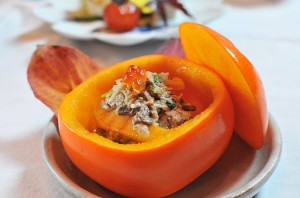Japanese food culture (3) 2015/09/18
One of typical traditional Japanese cuisines is called “kaiseki” which is originated from tea ceremony and presents multi-course traditional dishes.
It is a collection of many kinds of skillful dishes in small quantity.
Above represents Japanese preference on quality and diversity rather than volume.
Until recently, Meimeizenn has been popularly used at each home. Meimeizenn is a small dining table designed respectively for each member of a family, such as the Meimeizenn for farther, for mother, for an elder son or for a younger son and so on.
Nowadays it is seldom to use Meimeizenn, however we still use each person’s own rice cup or own chopsticks.
These customs represent how carefully we have been paying attention on human relations, which is one of typical features of Japanese society.
As mentioned above, Japanese cuisine has tremendous valuable features which have been cultivated during long history from Jomon era. However it has been having a rather hard time after the defeat of world war second. Since Japanese society tends to follow western way of life style including food.
Nevertheless the move comes as the nation faces a low food self-sufficiency rate of around 40 percent and the spread of Western eating habits.
Traditional Japanese cuisine was added to UNESCO’s Intangible Cultural Heritage list Dec. 4. 2013, raising the government’s hopes of enhancing its global recognition, attracting more foreign tourists and boosting exports of the country’s agricultural products.
Japanese government raised following 4 points as the features of Japanese cuisine when they applied to Heritage list.
a. Using various kinds of fresh materials by maximizing their real taste and specific features.
b. Healthy food with well balanced nutrition.
c. Presentation of beautiful nature and seasonal changes.
d. Close relation with annual and seasonal events.








